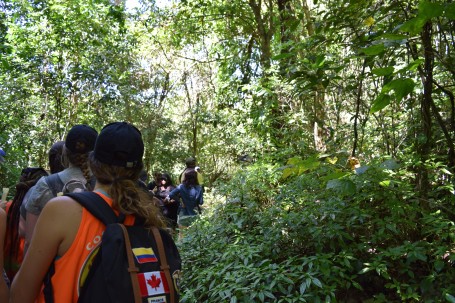
That’s probably the first thing I asked myself when I learned our cohort was going to have the opportunity to go see and understand better the food system in Jamaica. Reading articles and watching documentaries allowed me to have some insights into what to expect once we arrived, but now that the field trip is over, I realized how much more I was able to understand and appreciate the reality of food in this beautiful country.
Our days there were organized in a way where we would be able to see the process food went through in order to get to our table; from the farms to the markets and finally the households. With this in mind, I went on the trip with an open mind, and ready to learn about Jamaican food culture.
We started off our first day helping out in the kitchen for the preparation of breakfast. The ladies at the Hillcrest Diocesan Retreat Centre were extremely patient with all of our questions about fruits we did not know about and slower pace as we learned how to prepare certain foods, like the Ackee fruit. From this first interaction with food, we were told about the items that were produced locally and those that were imported. For instance, beans and salted cod were imported from North America, while most of the fruits and vegetables were grown locally.
Later that day, we all got together and brainstormed a few questions we had prior to seeing more of the local food system and talked about what we expected to learn by the end of the trip. It was enlightening, hearing all the different perspectives we all had at the beginning of this journey because it gave me more things to think about. Some students had questions about the influence of the economy and accessibility, while others asked questions about food distribution and exports among other topics.
The following part of our trip included hiking through the Jamaican Alps, where our guide showed us a number of plants and flowers that had many different uses. There were plants that helped back pain when boiled with water, others that were used as paint and even as ingredients for lipstick, flowers that collected water were used as eye drops, and many others that helped to strengthen the immune system among other things.
The following day we were able to visit two small-scale farms, where I learned there is a significant focus on potatoes and vegetable farming. Some of the most common crops we saw included onions, peppers, cabbage, carrots, corn, yam, and other vegetables. However, there was not a lot of focus on fruit crops, which was very surprising to me since the tropical weather usually is ideal for fruit production. We did see trees for bananas, plantains, mangos and pineapples, but there was not as much space dedicated to these crops when compared to the vegetables. We also had the chance to visit some greenhouses where the local farmers were growing broccoli, strawberries and green peppers. These items were part of a bigger-scale farm and are to be sold only to resorts and hotels. Both types of farms were very different from each other in terms of size, distribution, irrigation among other things, yet at the same time, both focus on similar products, which was an interesting link to see.

Lastly, we visited Brown’s Town market on Friday to see what kind of foods farmers and local vendors sold there. We had the opportunity to meet and talk with the market manager; she told us about the market dynamics, and how some of the sellers come from other cities like Kingston, Ocho Rios and other towns close by to Brown’s Town. She talked about the history of the market and how it has expanded over the last few years. Now you can not only find food products but also people have started to sell clothes, shoes, accessories and more. The market at Brown’s Town was very busy with sellers and buyers; fruits that were produced locally were cheaper than those that were imported, and the sellers were willing to give discounts on the former rather than the latter. It was interesting to take part in the barter for some fruits with some classmates.
Ultimately, I had to ask myself the same question I did at the beginning of the journey. What do I know about Jamaica’s food system? Well, I think what we learned in one week is not enough to answer all the questions that we initially had and not enough time to understand everything that takes place in the process of getting the food from the farm to the table. However, I learned how important nature is to Jamaican’s, how reliant locals are on it and how much advantage people take of off everything that nature offers them in a non-invasive manner. I learned that farmers are trying to use their strengths in order to become independent in certain product markets. I know more about fruits I had never seen before and the proper way to cook them. I think at the end of the trip I gained knowledge in Jamaican culture, food, music and beliefs. It was an incredible opportunity and having the chance to interact with local organizations gave us insights that we would not have been able to attain otherwise.

Alejandra is a student in the 5th Cohort of the Master’s of Development Practice Program. Her research interests are in poverty alleviation and livelihood, social and political development, local economic development, conflict resolution and refugee rights.

Hi Alejandre, good overview. I would gently caution you on your use of “they” and “she.” Local people should not be reduced to “they.” Explain who you are referring to in each instance IE local farmers, market vendors etc otherwise very clear writing, sounds like a productive learning experience!
LikeLike
Thank you for your feedback Grainne! I will make corrections on that.
LikeLike